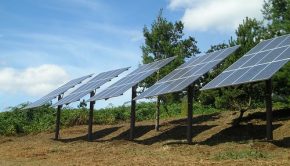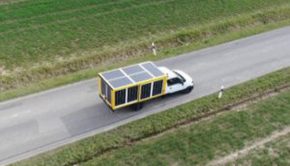Why should corporations choose onsite solar? Meaningful savings, grid stabilization and conflict reduction –
Why should corporations choose onsite solar? Meaningful savings, grid stabilization and conflict reduction –
According to the Solar Energy Industries Association (SEIA), corporations spent more on solar energy than ever before in 2019. Apple, Amazon, Target, Walmart and Google are among the most well-known names that are leading the charge, but large-scale businesses across the country are exploring the possibility of adding solar to their electricity-generation portfolio. In fact, SEIA says U.S. businesses have installed more than 15 times the amount of solar power than they did only a decade ago.
Related: Amazon announces plans to purchase 3.4 GW of solar and wind capacity
But the question for these corporations is this: Should they build their solar array onsite or connect with a large utility-scale project offsite? While early adapters tended to build their arrays onsite, the most recent trend is for large, multistate companies to invest in utility-scale sized installations that feed into the grid (front the meter) instead of directly sending power to their properties with behind the meter projects.
Not all major corporations have made the decision to build offsite solar arrays, however. Data management and security firm Iron Mountain, for example, recently decided to build 5 megawatts (MW) of rooftop solar arrays over five states to help the company meet its RE100 goal of 100% renewable electricity for its global operations. It recognized early on that with the amount of roof space they have on their data centers and other facilities, building onsite solar made much more sense for them than the alternative.
And Iron Mountain may be on to something. While it’s encouraging to see the use of solar energy and other renewables under any circumstances, there are solid arguments to be made about why the better investment may be onsite solar instead. Not only can it save money on electrical expenses, but it can also promote a stronger environment, lower grid use during peak hours and avoid possible conflicts with regional stakeholders during an array’s installation.
Location, location, location
When businesses examine how much they spend on energy, they will discover that there are generally three major components to it. First is the payment for the energy itself; businesses pay a certain rate for the number of kilowatt-hours they use per month.
Other aspects of the bill are transmission and distribution (T&D) charges as well as peak-demand charges. Generally speaking, these charges will not be offset by remotein front of the meter solar projects. When combined, they can represent up to two-thirds of electricity charges.
By using onsite behind the meter solar, energy buyers will certainly offset the T&D charges for every kilowatt-hour (kWh) made by the solar array. Peak-demand charges should be analyzed against the customer’s 15-minute interval data to see if the solar project can have an impact. But this is an area of some uncertainty, as it is both specific to the customer’s usage and variations in daily weather patterns.
Transmitting and distributing electricity from a remote site means that electricity still needs to travel hundreds and sometimes thousands of miles to where it is consumed. During this process, a certain percentage of the energy is lost in the form of heat. Maintaining and updating this infrastructure is costly and has environmental effects of its own.
Onsite solar stabilizes the grid by reducing the strain on transmission & distribution lines, meaning fewer repairs and upgrades are necessary for utilities. Broadly, it also prevents wear-and-tear on equipment, which lessens the chances of the system breakdowns that cause blackouts like the ones seen in California and elsewhere.
Finally, wetlands and other environmentally sensitive areas don’t have to be damaged by significant infrastructure upgrades to carry increased electrical loads because companies are producing their own power. In other words, onsite solar provides wider societal benefits beyond the immediate cost savings to individual businesses.
Land-use conflict resolution
Finally, as offsite solar arrays have grown in popularity throughout the United States, so has local opposition to some of these projects. While the benefits of solar are often clear—increased local, well-paying jobs, lower carbon emissions and long-term increases in property taxes for localities—it still takes time to educate local stakeholders about those benefits, which can sometimes increase costs for the companies in question.
Since onsite solar projects are typically self-contained on property the company owns (whether that’s rooftops, carports or some other plots of company land), they usually don’t arouse local resistance. As a result, the overall costs of getting a project done are significantly less, and the solar savings can drop immediately to a company’s bottom line.
Though offsite solar projects for companies are fine if the economics of them work out, taking a holistic approach to building your solar array may just prove that onsite solar is the way to go.
About the Author

Eric Partyka is the Director of Business Development at Standard Solar, a leading solar energy company specializing in the development and financing of commercial solar electric systems nationwide. He is a 12 year veteran of the solar industry having worked at SunEdison, the DOE and Carlisle Construction Materials. He received his Master’s in Energy & Environmental Policy from the University of Delaware.









